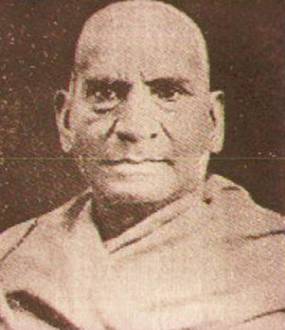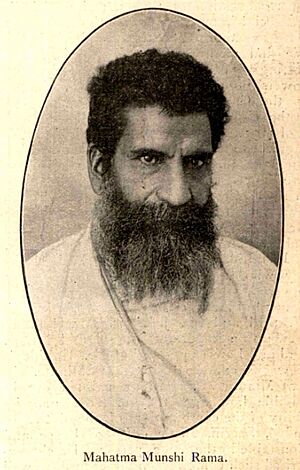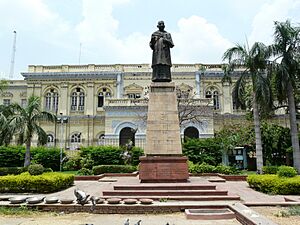Swami Shraddhanand facts for kids
Quick facts for kids
Swami
Shraddhanand
|
|
|---|---|
 |
|
| Born | 22 February 1856 Talwan, Jalandhar, Punjab, India
|
| Died | 23 December 1926 (aged 70) Delhi, India
|
| Cause of death | Assassination |
| Known for | Social worker Freedom Fighter Independence Activist Teacher Religious Leader |
Swami Shraddhanand (22 February 1856 – 23 December 1926), also known as Mahatma Munshi Ram Vij, was an Arya Samaj sannyasi and an Indian Independence activist who propagated the teachings of Dayananda Saraswati. This included the establishment of educational institutions, like the Gurukul Kangri University, and played a key role on the Sangathan (consolidation and organization) and the Shuddhi (purification), a Hindu reform movement in the 1920s.
Contents
Early life and education
He was born on 22 February 1856 in the village of Talwan in the Jalandhar District of the Punjab Province of India. He was the youngest child in the family of Lala Nanak Chand, who was a Police Inspector in the United Provinces (now Uttar Pradesh), then administered by the East India Company. His given name was Brihaspati Vij, but later he was called Munshi Ram Vij by his father, a name that stayed with him till he took sanyas in 1917, variously as Lala Munshi Ram Vij and Mahatma Munshi Ram.
He adopted atheism after a few incidents, such as when he was prevented from entering the temple while a noble woman was praying. He eventually passed mukhtari exams and began studying law from Punjab University Law College to become a lawyer.
Meeting Dayanand
He first met Dayanand Saraswati when Dayanand visited Bareilly to give lectures. His father was handling arrangements and security at the events, due to the attendance of some prominent personalities and British officers. Munshiram attend the lectures at his father's request. He originally went with the intent of spoiling the arrangements, then claimed to be strongly influenced by Dayanand's courage, skill, and strong personality. After completing his studies Munshiram started his practice as lawyer.
Career
Schools
In 1892 Arya Samaj was split into two factions after a controversy over whether to make Vedic education the core curriculum at the DAV College Lahore. He left the organization and formed the Punjab Arya Samaj. The Arya Samaj was divided between the Gurukul Section and the DAV Section. Shraddhanand headed for Gurukuls. In 1897, when Pandit Lekh Ram was assassinated, Shraddhanand succeeded him. He headed the 'Punjab Arya Pratinidhi Sabha', and started its monthly journal, Arya Musafir. In 1902 he established a Gurukul in Kangri, India near Haridwar. This school is now recognized as Gurukul Kangri University.
In 1917, Mahatma Munshi Ram took sanyas as "Swami Shradhanand Saraswati".
Shraddhanand established Gurukul Indraprashtha in Aravali near Faridabad, Haryana.
Activism
In 1917, Shraddhanand left Gurukul to become an active member of the Hindu reform movements and the Indian Independence movement. He began working with the Congress, which he invited to hold its session at Amritsar in 1919. This was because of the Jalianwala massacre, and no one in the Congress Committee disagreed to have a session at Amritsar. Motilal Nehru presided over the session.
He also joined the nationwide protest against the Rowlatt Act. The same year he protested in front of a posse of Gurkha soldiers at the Clock Tower in Chandni Chowk, then was allowed to proceed. In the early 1920s he emerged as an important force in the Hindu Sangathan (consolidation) movement, which was a by product of the now revitalised Hindu Mahasabha.
Swami Shradhanand was the only Hindu Sanyasi who addressed a huge gathering from the minarets of the main Jama Masjid New Delhi, for national solidarity and Vedic dharma starting his speech with the recitation of Vedic mantras.
He wrote on religious issues in both Hindi and Urdu. He published newspapers in the two languages as well. He promoted Hindi in the Devanagri script, helped the poor and promoted the education of women. By 1923, he left the social arena and plunged whole-heartedly into his earlier work of the shuddhi movement (re-conversion to Hinduism), which he turned into an important force within Hinduism. In 1922, Dr. Ambedkar called Shraddhanand “the greatest and most sincere champion of the Untouchables”.
In late 1923, he became the president of Bhartiya Hindu Shuddhi Sabha, created with an aim of reconverting Muslims, specifically 'Malkana Rajputs' in the western United Province. This brought him into direct confrontation with Muslim clerics and leaders of the time. 1,63,000 Malkana Rajputs were converted back to Hindu fold due to this movement.
Assassination
On 23 December 1926, Shraddhanand was assassinated by Abdul Rashid who said he murdered Shraddhanand over his comments on Islamic prophet Muhammad. Rashid was executed in 1927. Gandhi objected to the execution of Rashid.
Today, the 'Swami Shraddhanand Kaksha' at the archeological museum of the Gurukul Kangri University in Haridwar houses a photographic journey of his life.
A statue of him was placed in front of Delhi Town Hall after independence, replacing a statue of Queen Victoria. This location in Old Delhi is termed ghantaghar because the old clock tower stood here until the 1950s.
Personal life
Shraddhanand and his wife Shiva Devi had two sons and two daughters. His wife died when Shraddhanand was only 36 years old. His granddaughter Satyavati was a prominent opponent of the British rule in India.
See also
- Arya Samaj
- Hindu reformists





